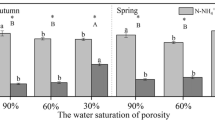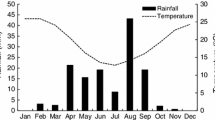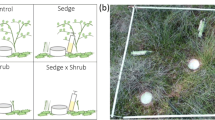Abstract
Aims
Climate warming in northern ecosystems is triggering widespread permafrost thaw, during which deep soil nutrients, such as nitrogen, could become available for biological uptake. Permafrost thaw shift frozen organic matter to a saturated state, which could impede nutrient uptake. We assessed whether soil nitrogen can be accessed by the deep roots of vascular plants in thermokarst bogs, potentially allowing for increases in primary productivity.
Methods
We conducted an ammonium uptake experiment on Carex aquatilis Wahlenb. roots excavated from thermokarst bogs in interior Alaska. Ammonium uptake capacity was compared between deep and shallow roots. We also quantified differences in root ammonium uptake capacity and plant size characteristics (plant aboveground and belowground biomass, maximum shoot height, and maximum root length) between the actively-thawing margin and the centre of each thermokarst bog as a proxy for time-following-thaw.
Results
Deep roots had greater ammonium uptake capacity than shallow roots, while rooting depth, but not belowground biomass, was positively correlated with aboveground biomass. Although there were no differences in aboveground biomass between the margin and centre, our findings suggest that plants can benefit from investing in the acquisition of resources near the vertical thaw front.
Conclusions
Our results suggest that deep roots of C. aquatilis can contribute to plant nitrogen uptake and are therefore able to tolerate anoxic conditions in saturated thermokarst bogs. This work furthers our understanding of how subarctic and wetland plants respond to warming and how enhanced plant biomass production might help offset ecosystem carbon release with future permafrost thaw.



Similar content being viewed by others
References
Aerts R, Wallén B, Malmer N (1992) Growth-limiting nutrients in Sphagnum-dominated bogs subject to low and high atmospheric nitrogen supply. J Ecol 80:131–140. https://doi.org/10.2307/2261070
Armstrong W, Cousins D, Armstrong J, Turner DW, Beckett PM (2000) Oxygen distribution in wetland plant roots and permeability barriers to gas-exchange with the rhizosphere: a microelectrode and modelling study with Phragmites australis. Ann Bot 86:687–703. https://doi.org/10.1006/anbo.2000.1236
Baltzer JL, Veness T, Chasmer LE, Sniderhan AE, Quinton WL (2014) Forests on thawing permafrost: fragmentation, edge effects, and net forest loss. Glob Change Biol 20:824–834. https://doi.org/10.1111/gcb.12349
Benstead J, Lloyd D (1996) Spatial and temporal variation of dissolved gases (CH4, CO2, and O2) in peat cores. Microb Ecol 31:57–66. https://doi.org/10.1007/BF00175075
Billings WD, Peterson KM, Shaver GR (1978) Growth, turnover, and respiration rates of roots and tillers in tundra graminoids. In: Tieszen LL (ed) Vegetation and production ecology of an Alaskan arctic tundra. Springer-Verlag, New York, pp 416–434
Britto DT, Kronzucker HJ (2013) Ecological significance and complexity of N-source preference in plants. Ann Bot 112:957–963. https://doi.org/10.1093/aob/mct157
Chen H, Qualls RG, Miller GC (2002) Adaptive responses of Lepidum latifolium to soil flooding: biomass allocation, adventitious rooting, aerenchyma formation and ethylene production. Environ Exp Bot 48:119–128. https://doi.org/10.1016/S0098-8472(02)00018-7
Chen H, Qualls RG (2003) Anaerobic metabolism in the roots of seedlings of the invasive exotic Lepidum latifolum. Environ Exp Bot 50:29–40. https://doi.org/10.1016/S0098-8472(02)00112-0
Colmer TD (2003) Long-distance transport of gases in plants: a perspective on internal aeration and radial oxygen loss from roots. Plant Cell Environ 26:17–36. https://doi.org/10.1046/j.1365-3040.2003.00846.x
Finger RA, Turetsky MR, Kielland K, Ruess RW, Mack MC, Euskirchen ES (2016) Effects of permafrost thaw on nitrogen availability and plant soil-interactions in a boreal Alaska lowland. J Ecol 104:1542–1554. https://doi.org/10.1111/1365-2745.12639
Glass ADM, Britto DT, Kaiser BN, Kinghorn JR, Kronzucker HJ, Kumar A, Okamoto M, Rawat S, Siddiqi MY, Unkles SE, Vidmar JJ (2002) The regulation of nitrate and ammonium transport systems in plants. J Exp Bot 53:855–864. https://doi.org/10.1093/jexbot/53.370.855
Güsewell S (2005) High nitrogen: phosphorus ratios reduce nutrient retention and second-year growth of wetland sedges. New Phytol 166:537–550. https://doi.org/10.1111/j.1469-8137.2005.01320.x
Harden JW, Manies KL, Turetsky MR, Neff JC (2006) Effects of wildfire and permafrost on soil organic matter and soil climate in interior Alaska. Glob Change Biol 12:2391–2403. https://doi.org/10.1111/j.1365-2486.2006.01255.x
Hewitt RE, Taylor DL, Genet H, McGuire AD, Mack MC (2019) Below-ground plant traits influence tundra plant acquisition of newly thawed permafrost nitrogen. J Ecol 107:950–962. https://doi.org/10.1111/1365-2745.13062
Howitt SM, Udvardi MK (2000) Structure, function and regulation of ammonium transporters in plants. Biochim Biophys Acta 1465:152–170. https://doi.org/10.1016/S0005-2736(00)00136-X
Hodgkins SB, Tfaily MM, McCalley CK, Logan TA, Crill PM, Saleska SR, Rich VI, Chanton JP (2014) Changes in peat chemistry associated with permafrost thaw increase greenhouse gas production. P Natl Acad Sci USA 111:5819–5824. https://doi.org/10.1073/pnas.1314641111
Hong E, Perkins R, Trainor S (2014) Thaw settlement hazard of permafrost related to climate warming in Alaska. Arctic 67:93–103. https://doi.org/10.14430/arctic4368
Hribljan JA, Kane ES, Pypker TG, Chimner RA (2014) The effect of long-term water table manipulations on dissolved organic carbon dynamics in a poor fen peatland. J Geophys Res Biogeosci 119:577–595. https://doi.org/10.1002/2013JG002527
Keuper F, van Bodegom PM, Dorrepaal E, Weedon JT, van Hal J, van Logtestijn RSP, Aerts R (2012) A frozen feast: thawing permafrost increases plant-available nitrogen in subarctic peatlands. Glob Change Biol 18:1998–2007. https://doi.org/10.1111/j.1365-2486.2012.02663.x
Keuper F, Dorrepaal E, van Bogedom PM, van Logtestijn R, Venhuizen G, van Hal J, Aerts R (2017) Experimentally increased nutrient availability at the permafrost thaw front selectively enhances biomass production of deep-rooting subarctic peatland species. Glob Change Biol 23:4257–4266. https://doi.org/10.1111/gcb.13804
Kirk G (2004) The biochemistry of submerged soils. Wiley, West Sussex
Klapstein SJ, Turetsky MR, McGuire AD, Harden JW, Czimczik CI, Xu X, Chanton JP, Waddington JM (2014) Controls on methane released through ebullition in peatlands affected by permafrost degradation. J Geophys Res-Biogeo 119:418–341. https://doi.org/10.1002/2013JG002441
Lamit LJ, Romanowicz KJ, Potvin LR, Rivers AR, Singh K, Lennon JT, Tringe SG, Kane ES, Lilleskov EA (2017) Patterns and drivers of fungal community depth stratification in Sphagnum peat. FEMS Microbiol Ecol 93:1–14. https://doi.org/10.1093/femsec/fix082
Lara MJ, Genet H, McGuire AD, Euskirchen ES, Zhang Y, Brown DRN, Jorgenson MT, Romanovsky V, Breen A, Bolton WR (2016) Thermokarst rates intensify due to climate change and forest fragmentation in an Alaskan boreal forest lowland. Glob Change Biol 22:816–829. https://doi.org/10.1111/gcb.13124
Laskov C, Horn O, Hupfer M (2006) Environmental factors regulating the radial oxygen loss from roots of Myriophyllum spicatum and Potamogeton crispus. Aquat Bot 84:333–340. https://doi.org/10.1016/j.aquabot.2005.12.005
Lindgren A, Hugelius G, Kuhry P (2018) Extensive loss of past permafrost carbon but a net accumulation into present-day soils. Nature 560:219–222. https://doi.org/10.1038/s41586-018-0371-0
Liu Y, von Wirén N (2017) Ammonium as a signal for physiological and morphological responses in plants. J Exp Bot 68:2581–2592. https://doi.org/10.1093/jxb/erx086
McFarlane KJ, Yanai RD (2006) Measuring nitrogen and phosphorus uptake by intact roots of mature Acer saccharum marsh., Pinus resinosa Ait., and Picea abies (L.) karst. Plant Soil 279:163–172. https://doi.org/10.1007/s11104-005-0838-2
Megonigal JP, Rabenhorst M (2013) Reduction-oxidation potential and oxygen. In: DeLaune RD, Reddy KR, Richardson CJ, Megonigal JP (eds) Methods in biogeochemistry wetlands. Soil Science Society of America, Madison, pp 71–85
Munir TM, Khadka B, Xu B, Strack M (2017) Mineral nitrogen and phosphorus pools affected by water table lowering and warming in a boreal forested peatland. Ecohydrology 10:e1893. https://doi.org/10.1002/eco.1893
Natali SM, Schuur EAG, Trucco C, Hicks Pries CE, Crummer KG, Baron Lopez AF (2011) Effects of experimental warming of air, soil and permafrost on carbon balance in Alaskan tundra. Glob Change Biol 17:1394–1407. https://doi.org/10.1111/j.1365-2486.2010.02303.x
Natali SM, Schuur EAG, Rubin RL (2012) Increased plant productivity in Alaska tundra as a result of experimental warming of soil and permafrost. J Ecol 100:488–498. https://doi.org/10.1111/j.1365-2745.2011.01925.x
Osterkamp TE, Viereck L, Shur Y, Jorgensen MT, Racine C, Doyle A, Boone RD (2000) Observations of thermokarst and its impact on boreal forests in Alaska, U.S.a. Arct Antarct Alp Res 32:303–315. https://doi.org/10.1080/15230430.2000.12003368
Osterkamp TE, Jorgenson MT, Schuur EAG, Shur YL, Kanevskiy MZ, Vogel JG, Tumskoy VE (2009) Physical and ecological changes associated with warming permafrost and thermokarst in interior Alaska. Permafrost Periglac 20:235–256. https://doi.org/10.1002/ppp.656
Pedersen EP, Elberling B, Michelsen A (2020) Foraging deeply: depth-specific plant nitrogen uptake in response to climate-induced N-release and permafrost thaw in the high Arctic. Glob Change Biol 26:6523–6536. https://doi.org/10.1111/gcb.15306
Pezeshki SR, DeLaune RD (2012) Soil oxidation-reduction in wetlands and its impact on plant functioning. Biology 1:196–221. https://doi.org/10.3390/biology1020196
Rennenberg H, Schneider S, Weber P (1996) Analysis of uptake and allocation of nitrogen and Sulphur compounds by trees in the field. J Exp Bot 47:1491–1498. https://doi.org/10.1093/jxb/47.10.1491
Rodenhizer H, Ledman J, Mauritz M, Natali SM, Pegoraro E, Plaza C, Romano E, Schädel C, Taylor M, Schuur E (2020) Carbon thaw rate doubles when accounting for subsidence in a permafrost warming environment. J Geophys Res-Biogeo 125:e2019JG005528. https://doi.org/10.1029/2019JG005528
Romanowicz KJ, Kane ES, Potvin LR, Daniels AL, Kolka RK, Lilleskov EA (2015) Understanding drivers of peatland extracellular enzyme activity in the PEATcosm experiment: mixed evidence for enzymatic latch hypothesis. Plant Soil 397:371–386. https://doi.org/10.1007/s11104-015-2746-4
Ryser P, Gill HK, Byrne CJ (2011) Constraints of root response to waterlogging in Alisma triviale. Plant Soil 343:247–260. https://doi.org/10.1007/s11104-011-0715-0
Salmon VG, Soucy P, Mauritz M, Celis G, Natali SM, Mack MC, Schuur EAG (2016) Nitrogen availability increases in a tundra ecosystem during five years of experimental permafrost thaw. Glob Change Biol 22:1927–1941. https://doi.org/10.1111/gcb.13204
Salmon VG, Schädel C, Bracho R, Pegoraro E, Celis G, Mauritz M, Mack MC, Schuur EAG (2018) Adding depth to our understanding of nitrogen dynamics in permafrost soils. J Geophys Res Biogeosci 123:2497–2512. https://doi.org/10.1029/2018JG004518
Schuur EAG, McGuire AD, Schädel C et al (2015) Climate change and the permafrost carbon feedback. Nature 520:171–179. https://doi.org/10.1038/nature14338
Schuur EAG, McGuire AD, Romanovsky VC, Schädel C, Mack M (2018) Chapter 11: Arctic and boreal carbon. In: Cavallaro et al. (ed) second state of the carbon cycle report (SOCCR2): a sustained assessment report. U.S. global change research program, Washington, DC, USA, pp. 428-468. https://doi.org/10.7930/SOCCR2.2018.Ch11
Tande G, Lipkin R (2003) Wetland sedges of Alaska. Alaska Natural Heritage Program Environment and Natural Resources Institute, Anchorage
Turetsky MR, Abbott BW, Jones MC (2019) Permafrost collapse is accelerating carbon release. Nature 569:32–24. https://doi.org/10.1038/d41586-019-01313-4
Turner JC, Moorberg CJ, Wong A, Shea K, Waldrop MP, Turetsky MR, Neumann RB (2020) Getting to the root of plant-mediated methane emissions and oxidation in a thermokarst bog. J Geophys Res-Biogeo 125:e2020JG005825. https://doi.org/10.1029/2020JG005825
van Dijk J, Robroek B, Kardel I, Wassen M (2012) Combined effects of nitrogen enrichment, Sulphur pollution and climate change on fen meadow vegetation N:P stoichiometry and biomass. Biogeochemistry 111:139–150. https://doi.org/10.1007/s10533-011-9694-8
Vitousek PM, Howarth RW (1991) Nitrogen limitation on land and in the sea: how can it occur? Biogeochemistry 13:87–115. https://doi.org/10.1007/BF00002772
Acknowledgements
We thank Hafiz Maherali and Catherine Dieleman for assistance with reviewing this manuscript, Sheila Macfie and Lola Oliver for assistance in N uptake experimental design, Natalie Zwanenburg, Danielle Rupp, Mike Falkowski, Bob Kremens, and Mark Winterstein for field assistance, Susan Procopio for assistance with lab measurements, Andrew McAdam, Samantha Miller, and Tobi Oke for assistance with statistics, and Tom Douglas and Peter Chang for assistance with ion chromatography. This research was supported by the National Science Foundation (grant DEB LTREB 1354370) to MRT and ESK, as well as the National Sciences and Engineering Research Council of Canada and Polar Knowledge Canada’s Northern Scientific Training Program fellowships to LJA. APEX is supported by the Bonanza Creek LTER (funded jointly by NSF grant DEB-0423442) and USDA Forest Service, Pacific Northwest Research Grant (PNW01-JV11261952-231).
Data accessibility
The datasets generated and analyzed during this study are available in the Bonanza Creek Long-Term Ecological Research program (BNZ LTER) Data Catalog. Data for the NH4+ uptake experiment at the APEX study area can be accessed at http://www.lter.uaf.edu/data/data-detail/id/735. Data for plant size characteristics at the APEX and Nenana Farms study areas can be accessed at http://www.lter.uaf.edu/data/data-detail/id/736.
Author information
Authors and Affiliations
Corresponding author
Additional information
Responsible Editor: Luca Bragazza.
Publisher’s note
Springer Nature remains neutral with regard to jurisdictional claims in published maps and institutional affiliations.
Supplementary Information
ESM 1
(DOCX 211 kb)
Rights and permissions
About this article
Cite this article
Albano, L.J., Turetsky, M.R., Mack, M.C. et al. Deep roots of Carex aquatilis have greater ammonium uptake capacity than shallow roots in peatlands following permafrost thaw. Plant Soil 465, 261–272 (2021). https://doi.org/10.1007/s11104-021-04978-x
Received:
Accepted:
Published:
Issue Date:
DOI: https://doi.org/10.1007/s11104-021-04978-x




